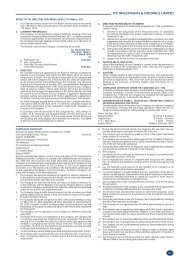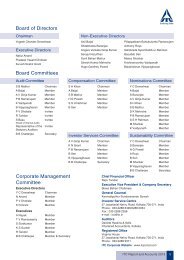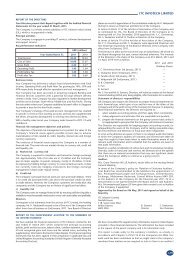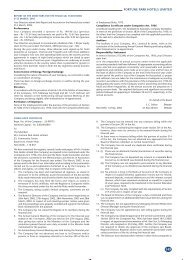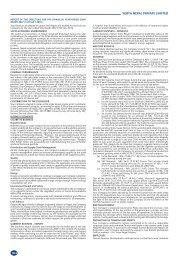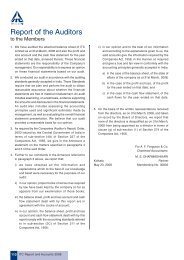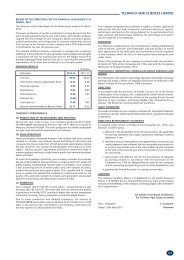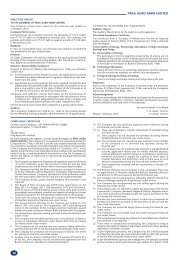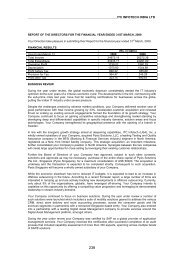SUBSIDIARY COMPANIES - ITC Ltd
SUBSIDIARY COMPANIES - ITC Ltd
SUBSIDIARY COMPANIES - ITC Ltd
Create successful ePaper yourself
Turn your PDF publications into a flip-book with our unique Google optimized e-Paper software.
NOTES TO THE ACCOUNTS<br />
27. Significant Accounting Policies<br />
1. Basis of Preparation<br />
The financial statements have been prepared and presented under the<br />
historical cost convention on the accrual basis of accounting and in<br />
accordance with the provisions of the Companies Act, 1956 (’the Act’)<br />
and the accounting principles generally accepted in India and comply<br />
with the accounting standards (’AS’) prescribed in the Companies<br />
(Accounting Standards) Rules, 2006 issued by the Central Government,<br />
in consultation with the National Advisory Committee on Accounting<br />
Standards, to the extent applicable.<br />
During the year ended March 31, 2012 (effective April 1, 2011), the<br />
revised Schedule VI notified under the Act has become applicable to<br />
Pavan Poplar Limited (’the Company’) for preparation and presentation<br />
of its financial statements. The adoption of revised Schedule-VI does<br />
not impact recognition and measurement principles followed for<br />
preparation of financial statements. All assets and liabilities have been<br />
classified as current or non-current as per the Company’s normal<br />
operating cycle and other criteria set out in the revised Schedule VI.<br />
2. Use of estimates<br />
The preparation of financial statements in conformity with generally<br />
accepted accounting principles (GAAP) in India requires management<br />
to make estimates and assumptions that affect the reported amounts<br />
of assets and liabilities and the disclosure of contingent liabilities on<br />
the date of the financial statements and actual results could differ from<br />
those estimates. Any revision to accounting estimates is recognized<br />
prospectively in current and future periods.<br />
3. Fixed Assets/Amortisation/Impairment/Depreciation<br />
Fixed Assets are stated at cost of acquisition less accumulated depreciation<br />
and impairment loss. Cost includes all expenses attributable to the<br />
acquisition and development of the assets.<br />
Leasehold Land is carried at cost less accumulated amortisation and<br />
impairment loss, if any. The lease agreement is effective up to 2031.<br />
Accordingly, expenditure incurred on leasehold land is amortised on<br />
a straight-line basis over the remaining period of the lease.<br />
In accordance with AS-28 Impairment of Assets, where there is an<br />
indication of impairment of the Company’s assets, the carrying amounts<br />
of the Company’s assets are reviewed at each balance sheet date to<br />
determine whether there is any impairment. The recoverable amount<br />
of the asset (or where applicable, that of the cash generating unit to<br />
which the asset belongs) is estimated as the higher of its net selling<br />
price and its value in use. An impairment loss is recognized whenever<br />
the carrying amount of an asset or a cash-generating unit exceeds its<br />
recoverable amount. Impairment loss is recognized in the profit and<br />
loss account or against revaluation surplus, where applicable.<br />
4. Inventories<br />
● In valuing poplar trees included under semi finished products, no<br />
adjustment is made to the total cost of the trees on account of<br />
undeveloped/diseased trees, being normal loss during the period<br />
of maturity of plantation (based on a technical estimate) except<br />
that realisation/insurance claim for such trees is reduced from the<br />
total cost. Every year, plantation cost already incurred is compared<br />
with the net realisable value which is determined on the basis of<br />
estimated selling price less estimated cost likely to be incurred in<br />
future for bringing the plantation to maturity and the cost necessarily<br />
to be incurred in order to make the sale.<br />
● Cost includes all direct and indirect expenses in respect of the<br />
poplar plantation.<br />
● Further, 75% of net standard realisable value of intercropping,<br />
waste, etc. is reduced from the above cost because the entire farm<br />
cost is first added to the cost of plantation.<br />
● Agricultural produce/standing crops and plants are valued at 75%<br />
of their net realisable value.<br />
5. Retirement benefits<br />
Short-term employee benefits<br />
All employee benefits payable wholly within twelve months of rendering<br />
the service are classified as short-term employee benefits. These<br />
benefits include compensated absences such as paid annual leave. The<br />
undiscounted amount of short-term employee benefits expected to be<br />
paid in exchange for the services rendered by employees is recognised<br />
during the period.<br />
Contributions to the provident fund, which is a defined contribution<br />
scheme, are charged to the Profit and Loss Account in the period in<br />
which the liability is incurred.<br />
PAVAN POPLAR LIMITED<br />
Post-employment benefits<br />
The Company’s gratuity benefit scheme is a defined benefit plan which<br />
is not funded. The Company’s obligation in respect of the gratuity<br />
benefit scheme is calculated by estimating the amount of future benefit<br />
that employees have earned in return for their service in the current<br />
and prior periods; that benefit is discounted to determine its present<br />
value.<br />
The present value of the obligation under such defined benefit plan<br />
is determined based on actuarial valuation using the Projected Unit<br />
Credit Method, which recognises each period of service as giving rise<br />
to additional unit of employee benefit entitlement and measures<br />
each unit separately to build up the final obligation. The obligation is<br />
measured at the present value of the estimated future cash flows. The<br />
discount rates used for determining the present value of obligation<br />
under defined benefit plan are based on the market yields on Government<br />
securities as at the balance sheet date.<br />
Actuarial gains and losses are recognized immediately in the statement<br />
of profit and loss.<br />
Other long-term employment benefits<br />
Compensated absences which are not expected to occur within twelve<br />
months after the end of the period in which the employee renders the<br />
related services are recognized as a liability at the present value of the<br />
defined benefit obligation at the balance sheet date. The discount<br />
rates used for determining the present value of the obligation under<br />
defined benefit plan are based on the market yields on Government<br />
securities as at the balance sheet date.<br />
6. Revenue recognition<br />
Revenue from sale of goods is recognized on transfer of all significant<br />
risks and rewards of ownership to the buyer.<br />
7. Contingencies and Provisions<br />
A provision is created where there is a present obligation as a result of<br />
a past event that probably requires an outflow of resources and a<br />
reliable estimate can be made of the amount of the obligation.<br />
A contingent liability is disclosed when there is a possible or a present<br />
obligation that may, but probably will not, require an outflow of<br />
resources and a reliable estimate can be made of the amount involved.<br />
Where there is a possible or a present obligation and the likelihood of<br />
outflow of resources is remote, no provision or disclosure is made.<br />
8. Taxation<br />
Income-tax expense comprises current tax and deferred tax charge or<br />
credit. Current tax is determined in accordance with the Income Tax<br />
Act, 1961. The deferred tax charge or credit and the corresponding<br />
deferred tax liabilities or assets are recognised using the tax rates and<br />
tax laws that have been enacted or substantively enacted by the balance<br />
sheet date. Deferred tax assets are recognised only to the extent there<br />
is reasonable certainty that the assets can be realised in future; however,<br />
where there is unabsorbed depreciation or carried forward loss under<br />
taxation laws, deferred tax assets are recognised only if there is a virtual<br />
certainty of realisation of such assets. Deferred tax assets are reviewed<br />
as at each balance sheet date and written-down or written-up to reflect<br />
the amount that is reasonably/virtually certain (as the case may be) to<br />
be realised. As the Company is engaged in growing and selling<br />
agricultural produce, such income is exempt from income tax.<br />
Accordingly, there are no deferred tax assets/liabilities arising therefrom.<br />
9. Earnings per share (‘EPS’)<br />
The basic earnings per share (’EPS’) is computed by dividing the net<br />
profit attributable to the equity shareholders for the period by the<br />
weighted average number of equity shares outstanding during the<br />
reporting period. Diluted EPS is computed by dividing the net<br />
profit attributable to the equity shareholders for the period by the<br />
weighted average number of equity and equivalent dilutive equity<br />
shares outstanding during the period, except where the results would<br />
be anti-dilutive.<br />
For BSR & Co.<br />
Chartered Accountants<br />
Firm’s Registration No: 101248W<br />
Bhavesh Dhupelia<br />
Partner<br />
Membership Number: 042070<br />
Mumbai, 26th April, 2012<br />
For and on behalf of the Board<br />
S. K. Sipani Director<br />
S. Limaye Director<br />
Dr. R. C. Dhiman Manager<br />
Kolkata, 26th April, 2012<br />
53




